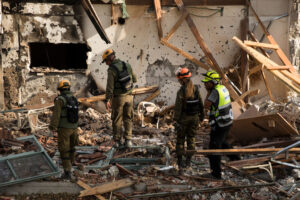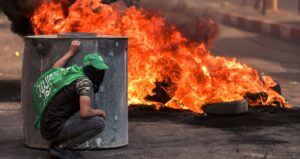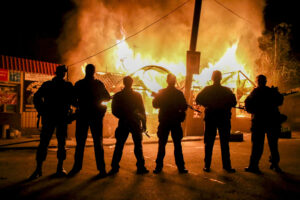This year marks the 30th anniversary of the signing of the Oslo Accords, a landmark moment in the pursuit of peace between Israel and the Palestinians. And yet peace in the region has never been more elusive, as events in Gaza makes dramatically clear. Why have all attempts to bring an end to one of the world’s bloodiest and longest-running wars failed?
To answer that, we have to go back to 1967, and the Six-Day War between Israel and its Arab neighbours, when the current Israeli-Palestinian status quo came into being. Israel captured the territories it had failed to occupy in 1948 — the Jordanian-controlled West Bank (including East Jerusalem) and the Egyptian-controlled Gaza Strip — putting all of historical Palestine under its control. This included, at the time, one million Palestinians in the West Bank and another 450,000 in the Gaza Strip.
Haaretz described the victory as “an event as monumental as the creation of the state of Israel in 1948”. Indeed, Israel’s military and political elite had been looking for the right moment to occupy the West Bank and the Gaza Strip since it had taken over most of Mandatory Palestine two decades prior, resulting in the expulsion of half of the country’s native population.
The decisions made in the immediate aftermath of this short war would define Israeli-Palestinian relations, and shape the Middle East, for the next half century — up until this very day. No wonder some have called it “the war that never ended”.
The immediate question for Israel was what to do with its newly occupied territories — and its inhabitants. There was widespread consensus that Israel should keep the West Bank and the Gaza Strip; however, a formal annexation would mean integrating Palestinians as equal citizens, thereby threatening the Jewish majority. At the same time, a 1948-style mass expulsion was not deemed a viable option, for domestic as well as international reasons.
So a different strategy was devised: one in which Israel would not formally annex the territories (except for East Jerusalem and parts of the West Bank), but place them — and the Palestinians living there — under military occupation. This satisfied both of the fundamental ideological prerequisites of Zionism: controlling as much of historical Palestine as possible, while maintaining a Jewish majority within Israel. There was only one problem: even though Israel promised to normalise the lives of the Palestinians in these territories, its political goals could only translate into a system of control and domination. The Israeli historian Ilan Pappé describes what emerged as “the largest mega-prison ever created”.
Only against the background of that 1967 decision can we understand why this regime has, in all but name, remained in place to this day — and why it has proved impervious to countless rounds of diplomatic negotiations. Not only was the decision made to effectively exclude the West Bank and the Gaza Strip from any future peace talks, but a policy of settler colonisation of the West Bank was also initiated that would make any prospect of turning it into an independent Palestinian state practically impossible.
The first time the issue of Palestinian autonomy was brought to the table was during the negotiations for the Egypt-Israel peace treaty of 1979. Israel agreed to return the Sinai Peninsula, which it had occupied in 1967, to Egypt — but also to grant a degree of administrative “autonomy” to the Palestinian inhabitants of the Occupied Territories, over which Israel would nonetheless continue to exercise significant control. The latter part of the agreement, however, was never implemented.
On the one hand, the Palestine Liberation Organization (PLO), led by Yasser Arafat, rejected the deal engineered by the Israelis and Egyptians, and intensified its armed struggle against the occupation. On the other, even though there were segments of Israeli society that favoured withdrawal, the consensus among the Israeli political and military establishment was that the territories should remain under Israeli rule. Indeed, throughout the Seventies and Eighties, under both Labor and Likud governments, the strategy remained the same as always; intensifying the colonisation of the West Bank — and crushing the PLO.
For a long time, “peace” — or, better, some form of compromise — was never really an option for either side. The PLO was committed to “the liberation of all Palestinian soil”, while Israel saw no need to change the way it managed the territories. This changed in 1987, when violent anti-occupation riots broke out throughout the Occupied Territories and Israel. It came to be known as the First Intifada.
The uprising coincided with the appearance of a new political force on the scene: Hamas, an offshoot of the Muslim Brotherhood, which opposed the PLO’s new policy, adopted in the late Eighties, consisting in accepting the existence of the state of Israel and pursuing a two-state solution. Hamas proved to be a double-edged sword for Israel: on the one hand it posed a serious military threat, but on the other it allowed Israel to brand the Palestinian struggle as part of a global anti-Western Islamic jihad.
This helps explain why Israel actually played an important role in propping up the organisation. Brig. Gen. Yitzhak Segev, who was the Israeli military governor in Gaza in the early Eighties, told the Jerusalem bureau chief of the New York Times that he was giving money to the Muslim Brotherhood, the precursor of Hamas, on the instruction of the Israeli authorities. The funding was intended to tilt power away from both communist and nationalist movements in Gaza, and especially from Arafat (who himself referred to Hamas as “a creature of Israel”), which Israel considered more threatening than the fundamentalists. “Hamas, to my great regret, is Israel’s creation”, Avner Cohen, a former Israeli religious affairs official who worked in Gaza for more than two decades, told the Wall Street Journal in 2009.
The First Intifada lasted until 1993. Throughout that period, the Israeli response was ruthless, transforming the open-air prison model into an even harsher maximum security prison. This is when the infamous checkpoint system was implemented.
By the time a new round of negotiations, the Oslo Accords, began in the early Nineties, under the aegis of the US administration, the situation on the ground in the West Bank made the prospect of reaching lasting peace, through the establishment of a geographically coherent Palestinian state, appear remoter than ever. Nonetheless, following secret talks between Israel and the PLO, in September 1993 the two parties unveiled a “historic peace deal” on the White House lawn in the presence of US President Bill Clinton. Arafat and Israel’s Prime Minister Yitzhak Rabin and Foreign Minister Shimon Peres would later receive the Nobel Peace Prize for this.
Under the deal, Israel would withdraw its military from Palestinian territory, and Palestinians would obtain self-governance over parts of the West Bank (excluding the illegal settlements) and the Gaza Strip — not an actual state but rather an “entity”, as Rabin put it. Meanwhile, Israel would maintain exclusive control of Gaza’s borders, airspace and territorial waters. Specific issues — Israeli settlements, Jerusalem’s status, Israel’s control over security, and the Palestinian right of return — would be settled in future discussions. A transitional five-year period was established for the implementation of the agreement, but — again — little progress was made.
A crucial factor in the stalling of the peace process was Rabin’s assassination, in 1995. On 4 November, Rabin led a massive demonstration in support of the peace deal in Tel Aviv. “Let’s make peace” were his final words. As he left the venue, an Israeli ultranationalist shot him twice. Ever since the negotiations had started, Rabin had become the target of Israeli extremists. Some Right-wing rabbis even proclaimed a din rodef — essentially an authorisation to kill in traditional Jewish law — against Rabin. Rallies organised by Likud, by now led by Benjamin Netanyahu, as well as other Right-wing groups featured depictions of Rabin in a Nazi SS uniform or in the crosshairs of a gun. Protestors chanted “Rabin is a murderer” and “Rabin is a traitor”.
Netanyahu himself was often present at these rallies. In July 1995, a few months before Rabin’s murder, he led a mock funeral procession featuring a coffin and hangman’s noose at a rally during which protesters chanted “Death to Rabin”. Over the years, Netanyahu has often been accused of encouraging incitement that led to Rabin’s killing, or at the very least of contributing to the incendiary political climate that led to the murder. “Rabin was murdered in a political assassination with the cooperation of Benjamin Netanyahu,” Merav Michaeli, leader of the Labor Party, went so far as to say, last year.
After Rabin’s death, new elections were scheduled. It seemed like a mere formality: Shimon Peres, who had taken Rabin’s place, was way ahead of Netanyahu in the polls. Then, in the weeks leading up to the elections, Hamas, which was also committed to derailing the peace talks, committed a series of terrorist attacks that dramatically shifted public opinion towards Netanyahu and his ultranationalist Likud. Six months after the assassination, he won the election.
The new prime minister’s objection to the Accords meant it ground to a halt. Meanwhile, for Palestinians, the reality on the ground worsened in many respects. The West Bank was divided into the areas A, B and C, with Israel controlling any movement between, and within them, effectively formalising the “bantustanisation” of the West Bank; meanwhile, Netanyahu continued construction within existing Israeli settlements and put forward plans for the construction of a new neighbourhood.
The peace process only started moving again when the Labor Party, under Ehud Barak, returned to power in 1999. Barak was determined to land a final agreement, and he enjoyed the full support of the Clinton administration. This led to the 2000 Camp David summit. On that occasion, Israel made its final offer, explicitly aimed for the first time at a two-state solution: it proposed a small Palestinian state, with a capital in a village near Jerusalem, Abu Dis, comprising Gaza and parts of the West Bank, with no significant dismantling of any settlements.
Several aspects of the future Palestinian state — security and the management of certain resources — would remain under Israeli control. The offer also included a categorical rejection of the Palestinian right of return, a long-standing Palestinian principle that all Palestinian refugees, including their descendants, should be entitled to return to the land they were expelled from.
The summit, however, ended without agreement — and a few months later another major Palestinian uprising, the Second Intifada, broke out. Which party (parties) should be blamed for the summit’s failure remains hotly debated. The Israelis and the Americans have always blamed Arafat for his unwillingness to compromise on territory and, even more importantly, to give up on the right of return.
Others, however, including Shlomo Ben-Ami, then-Israel’s Minister of Foreign Relations, who participated in the talks, have challenged this view, arguing that the Israelis and the Americans were at least as guilty as the Palestinians for the summit’s failure. According to Robert Malley, a member of the Clinton administration, the terms of the non-negotiable, give-or-take deal, proposed by Israel in Camp David were impossible for Arafat to uphold: Palestinians would have opposed them regardless of what their leader told them.
Israel’s “best offer”, after all, was a state comprising only portions of the remaining 20% of the Palestinian land occupied in 1967, whose economic and foreign policy would have largely remained under Israeli control. It’s not hard to see why many Palestinians thought such a deal was unacceptable. Moreover, Palestinians had lost faith in the peace process in general: life in the territories had worsened since the start of the Oslo Accords. This is why, as the US State Department’s Hussein Agha and Robert Malley recount in their summit report, Arafat came to the negotiating table demanding an end to the daily brutalisation of normal Palestinian life as a way to restore faith in the benefits of the peace process. But the Israelis refused to budge.
To place all the blame on the Israeli government, however, would be too simplistic. At this point, a majority of Israelis actually thought the government had already compromised too much. So what was not enough for most Palestinians was too much for most Israelis. No wonder the two parties failed to find any middle ground.
The growing anger and frustration of Palestinians eventually led to the outburst of the second Palestinian uprising, in the autumn of 2000, which reignited the cycle of violence and reprisal. Israelis blamed Arafat for instigating the violence, but several observers agreed that Ariel Sharon’s provocative visit to the Temple Mount, a Muslim holy site, is what likely triggered the Second Intifada. Sharon, an ultranationalist, won the elections the following year and used the unrest, in which 1,000 Israelis and more than 3,000 Palestinians were killed, as an excuse to block any further negotiations — and to justify a brutal crackdown in the West Bank in 2002.
This quelled the revolt, but also sowed the seeds of future violence. From that moment onwards, the goal of peace has moved further and further away into the distance. A small spiral opened in 2004, when Hamas leader Ahmed Yassin offered Israel a 10-year hudna — a truce, or armistice — in exchange for a two-state solution. We’ll never know if Hamas was serious about the offer — they had broken previous attempts at unofficial ceasefires — or if it was a mere tactical manoeuvre to allow the group to buy time in preparation for future attacks; Israel murdered Yassin two months later in a targeted air strike.
Relations between Israel and Gaza, in particular, have been deteriorating ever since, particularly since the election of Hamas in 2005 and 2006. Israel’s disengagement plan, in 2005, in which it unilaterally dismantled its settlements inside the Gaza Strip, only made things worse. From that moment on, Gaza essentially became, in Israel’s eyes, enemy territory, leading to a dramatic militarisation of Israel’s policy towards the Strip. This included the besieging and blockading of the Strip, which led to violent retaliation by Palestinian armed groups, including rockets launched into Israel. Over the years, Israel responded with several bombing campaigns, which led to the deaths of more than 6,000 Gazans between 2008 and 2021.
This, then, is the backdrop to Hamas’s brutal October 7 attack, which killed around 1,300 Israelis and triggered Israel’s military response, which has killed more than 5,000 Gazans, and created a humanitarian catastrophe. The conflict has renewed calls for a two-state solution. But this would require a serious commitment from the international community, which is also as fractured as ever. The grim reality is that peace — let alone a lasting political sentiment — has never been further from reach.
Disclaimer
Some of the posts we share are controversial and we do not necessarily agree with them in the whole extend. Sometimes we agree with the content or part of it but we do not agree with the narration or language. Nevertheless we find them somehow interesting, valuable and/or informative or we share them, because we strongly believe in freedom of speech, free press and journalism. We strongly encourage you to have a critical approach to all the content, do your own research and analysis to build your own opinion.
We would be glad to have your feedback.
Source: UnHerd Read the original article here: https://unherd.com/






